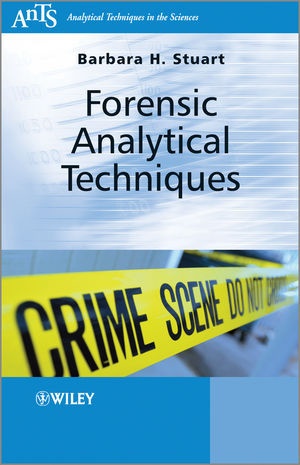Read more
Informationen zum Autor Barbara Stuart (BSc(Hons), MSc(Syd), PhD(Lond), DIC, MRSC, MRACI, Cchem) After graduating with a BSc degree from the University of Sydney in Australia, Barbara Stuart worked as a tutor at this university. She also carried out research in the field of biophysical chemistry in the Department of Physical Chemistry and graduated with a MSc in 1990. The author moved to the UK to carry out doctoral studies in polymer engineering within the Department of Chemical Engineering and Chemical Technology at Imperial College (University of London). After obtaining her PhD in 1993, she took up a position as Lecturer in Physical Chemistry at the University of Greenwich in London. Barbara joined the staff at the University of Technology, Sydney, Australia in 1995, where she is currently a Senior Lecturer in the Department of Chemistry, Materials and Forensic Science. She is presently conducting research in the fields of polymer spectroscopy, materials conservation and forensic science. Barbara is the author of four books published by Wiley, "Modern Infrared Spectroscopy", "Biological Applications of Infrared Spectroscopy", "Polymer Analysis" and "Infrared Spectroscopy: Fundamentals and Applications" in the current ANTS series of texts and "Analytical Techniques in Materials Conservation". Klappentext The book will be an open learning / distance learning text in the Analytical Techniques for the Sciences (AnTS) covering analytical techniques used in forensic science. No prior knowledge of the analytical techniques will be required by the reader.An introductory chapter will provide an overview of the science of the materials used as forensic evidence. Each of the following chapters will describe the techniques used in forensic analysis. The theory, instrumentation and sampling techniques will be explained and examples of the application of each technique to particular forensic samples will be provided. The reader will be able to assess their understanding with the use of regular self assessment questions and discussion questions throughout the book. The user of the book will be able to apply their understanding to the application of specific techniques to particular analyses encountered in their professional life. "I would recommend this work to chemistry students with an interest in the chemical analysis of forensic evidence." ("Chemistry & Industry", 1 July 2013) Zusammenfassung The book offers an open learning/distance learning text covering analytical techniques used in forensic science. After an introduction, chapters describe specific techniques including background theory, instrumentation, and sampling techniques, along with examples of their forensic samples. Inhaltsverzeichnis Series Preface xiii Preface xv About the Author xvii Acronyms, Abbreviations and Symbols xix 1 The Chemistry of Forensic Evidence 1 1.1 Introduction 1 1.2 Evidence Types 2 1.3 Introduction to Data Analysis 23 1.4 Summary 24 References 24 2 Preliminary Tests 27 2.1 Introduction 27 2.2 Chemical Tests 27 2.3 Density 32 2.4 Light Examination 35 2.5 Summary 39 References 39 3 Microscopic Techniques 41 3.1 Introduction 41 3.2 Optical Microscopy 42 3.3 Transmission Electron Microscopy 51 3.4 Scanning Electron Microscopy 54 3.5 Atomic Force Microscopy 59 3.6 X-Ray Diffraction 60 3.7 Summary 66 References 66 4 Molecular Spectroscopy 69 4.1 Introduction 70 4.2 Infrared Spectroscopy 70 4.3 Raman Spectroscopy 89 4.4 Ultraviolet-visible Spectroscopy 95 4.5 Fluorescence Spectroscopy 101 4.6 Nuclear Magnetic Resonance Spectroscopy 104 4.7 Summary 109 References 109 5 Elemental Analysis 113 5.1 Introduction 113 5.2 Atomic Spectrometry...
List of contents
Series Preface xiii
Preface xv
About the Author xvii
Acronyms, Abbreviations and Symbols xix
1 The Chemistry of Forensic Evidence 1
1.1 Introduction 1
1.2 Evidence Types 2
1.3 Introduction to Data Analysis 23
1.4 Summary 24
References 24
2 Preliminary Tests 27
2.1 Introduction 27
2.2 Chemical Tests 27 2.3 Density 32
2.4 Light Examination 35 2.5 Summary 39
References 39
3 Microscopic Techniques 41
3.1 Introduction 41
3.2 Optical Microscopy 42
3.3 Transmission Electron Microscopy 51 3.4 Scanning Electron Microscopy 54
3.5 Atomic Force Microscopy 59 3.6 X-Ray Diffraction 60
3.7 Summary 66
References 66
4 Molecular Spectroscopy 69
4.1 Introduction 70
4.2 Infrared Spectroscopy 70
4.3 Raman Spectroscopy 89
4.4 Ultraviolet-visible Spectroscopy 95
4.5 Fluorescence Spectroscopy 101 4.6 Nuclear Magnetic Resonance Spectroscopy 104
4.7 Summary 109
References 109
5 Elemental Analysis 113
5.1 Introduction 113
5.2 Atomic Spectrometry 114 5.3 Inductively Coupled Plasma-Mass Spectrometry 117
5.4 X-Ray Fluorescence Spectroscopy 119 5.5 Particle-Induced X-Ray Emission Spectroscopy 123
5.6 Neutron Activation Analysis 125
5.7 Summary 125
References 126
6 Mass Spectrometry 129
6.1 Introduction 129
6.2 Molecular Mass Spectrometry 129 6.3 Isotope Ratio Mass Spectrometry 134
6.4 Ion Mobility Spectrometry 137 6.5 Summary 140
References 140
7 Separation Techniques 143
7.1 Introduction 144
7.2 Paper Chromatography 144 7.3 Thin Layer Chromatography 145
7.4 Gas Chromatography 149 7.5 Liquid Chromatography 155
7.6 Ion Chromatography 159 7.7 Capillary Electrophoresis 161
7.8 Summary 163
References 164
8 Thermal Analysis 167
8.1 Introduction 167
8.2 Pyrolysis Techniques 168 8.3 Differential Scanning Calorimetry and Differential Thermal Analysis 171
8.4 Thermogravimetric Analysis 174 8.5 Summary 178
References 178
Bibliography 195
Glossary of Terms 197
SI Units and Physical Constants 203
Periodic Table 207
Index 209
Report
"I would recommend this work to chemistry students with an interest in the chemical analysis of forensic evidence." ( Chemistry & Industry , 1 July 2013)

